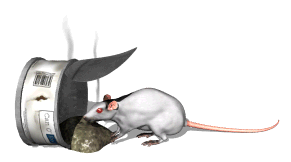Rodents Control Treatment

The word rodent means "to gnaw". Rodents will gnaw through many types of materials in order to reach a location including lead sheathing, cinderblock, aluminum siding and some concrete. They are able to squeeze through very small openings:1/4 inch for mice and 1/2 inch for rats
Rats and mice cause a huge loss of food worldwide. Besides eating our food they spoil it by contamination with their feces, urine, or fur. They can be found not only in our homes, but supermarkets, restaurants, warehouses, food processing facilities, livestock facilities, and farm fields. They reproduce rapidly with major activity at night

Rats tend to be cautious and mice are more curious. Rats tend to eat most of their food at one time, where mice will nibble a little at a time. They also cause damage to our buildings by their burrowing and gnawing activity.The three most common rodents sharing our households, restaurants, warehouses, barns and other buildings are the House Mouse, Norway Rat, Roof Rat. It is important to remove their food sources-but do not disturb the rodent habitat, until a complete knockdown and elimination occurs before they could move to another area.
A successful rodent control program includes a combination of baiting and trapping for the highest rate of success.
You may also want to consider integrating our program, with exclusion techniques and a general cleanup, removal of their hiding places (harboraging areas).
If the population is large, we want to begin with a high quality rodent bait, to quickly knock down a population and prevent rapid growth. There are different types of baits to choose, each rodent population is different in their preferences, so a little of good choice in bait selections
We take care when baiting initially , try not to disturb their original habitats or they may run to another area. After our baiting has begun, continue with sanitation procedures, food source removal, and harborage removal to ensure additional rodents from nearby areas are not attracted to your location.
We will be covering the three most common type of rodents : The HOUSE MOUSE, the NORWAY RAT, and the ROOF RAT.
Rats and Mouse Elimation
There are few basic steps to implement when confronting a rats infestation.

inspection
There are few signs that we look for, when conducting our initial (and follow-up) inspection are Droppings, Tracks, Gnaw marks, Burrowing, Runways, Grease marks, Urine stains, Live or Dead rats, Rats sounds and their odors. A good inspection gives you a better idea of the size of the population and the routes taken by the rodents. As in Population Reduction, we will intercept the rats. Proper placements of baits, traps or live traps depend on inspection.
Population Reduction :To quickly reduce the population of rats and mice, traps and/or baits are used. In some situations, the use of toxic baits are not safe, legal or desired because of possible odors. When dealing with rats and mice, we prefer a combination of traps and baits if possible. The Run-Way Live Mouse Trap can safely be used in areas where mouse baits are not appropriate. Consider your building, children, pets, ability to deal with possible odors and dangers to none target animals when choosing products to eliminate your mouse problem.
Non-chemical control with the use of traps
GLUE TRAPS :
In many circumstances, glue traps (or glue boards) are employed in rodent elimination and maintenance. In areas where food is commercially prepared, the use of rodenticides is unsafe. Glue traps are safe to use in homes, apartments, restaurants, hospitals, pet shops, day care centers, nursing homes and food preparation areas. This captures many of the rats before they die, giving a better chance of finding more carcasses before they begin to decompose and create odors. We place traps in path of rats, intercepting them between their nesting site and food source
Chemical control with the use of rodenticides
BAITING :
We place our baits in areas where there is evidence of mouse activity. Rats will readily consume bait pellets, rats most often prefer bait blocks. The shape of bait blocks being used by us is more attractive to rats and encourages them to consume more bait in a single feeding.We try to intercept the rats, placing baits between their possible harborage and food source. Rat baits should be placed 15 feet apart. We place baits in rat harborage such as burrows and ground voids.Rats (especially Roof Rats) could be living above or below their food source. We use this knowledge to properly place baits between the rats and his food source. To encourage rats to eat more of our bait, we place rodenticides in tamper resistant bait stations. Not only will this give the rat a cozy place to "pig-out" on our bait, it also keeps our bait fresh and attractive to rats. We never under-feed the population.Rats are not attracted to old, insect infested or moldy bait. We inspect often and replace or move undesirable baits and also see that it is not accidentally moved out of position. Once we have placed our rodenticides in their proper stations and locations, we insist avoid moving any objects in the baited area. The rats need time to adjust to anything new in their environment, so do not "rearrange the furniture.


